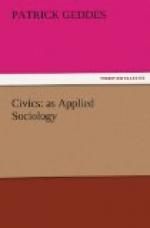The answer must plainly be a concrete one. Every city [Page: 116] however small, has already a copious literature of its topography and history in the past; one, in fact, so ample that its mere bibliography may readily fill a goodly volume,[1] to which the specialist will long be adding fresh entries. This mass of literature may next be viewed as the material for a comprehensive monograph, well enriched with maps and illustrations, such as many cities can boast; and this again may be condensed into a guide-book. Guide-books have long been excellent in their descriptive and historical detail, and are becoming increasingly interpretative also, especially since Mr. Grant Allen transferred his evolutionary insight and his expository clearness from natural to civic history.
[1] e.g., Erskine Beveridge, LL.D., Bibliography of Dunfermline.—Dunfermline, 1902. 8vo.
After this general and preliminary survey of geographic environment and historic development, there nowadays begins to appear the material of a complementary and contemporary volume, the Social Survey proper. Towards this, statistical materials are partly to be found amid parliamentary and municipal reports and returns, economic journals and the like, but a fresh and first-hand survey in detail is obviously necessary. In this class of literature, Mr. Booth’s monumental Survey of London, followed by others, such as Mr. Rowntree’s of York, have already been so widely stimulating and suggestive that it may safely be predicted that before many years the Social Survey of any given city will be as easily and naturally obtainable as is at present its guide-book; and the rationalised census of the present condition of its people, their occupation and real wages, their family budget and culture-level, should be as readily ascertainable from the one, as their antecedents understood or their monuments visited by help of the other.
But these two volumes—“The City: Past and Present,”—are not enough. Is not a third volume imaginable and possible, that of the opening Civic Future? Having taken full note of places as they were and are, of things as they have come about, and of people as they are—of their occupations, families, and institutions, their ideas and ideals—may we not to some extent discern, then patiently plan out, at length boldly suggest, something of [Page: 117] their actual or potential development? And may not, must not, such discernment, such planning, while primarily, of course, for the immediate future, also take account of the remoter and higher issues which a city’s indefinitely long life and correspondingly needed foresight and statesmanship involve? Such a volume would thus differ widely from the traditional and contemporary “literature of Utopias” in being regional instead of non-regional, indeed ir-regional and so realisable, instead of being unrealisable and unattainable altogether. The theme of such a volume would thus




